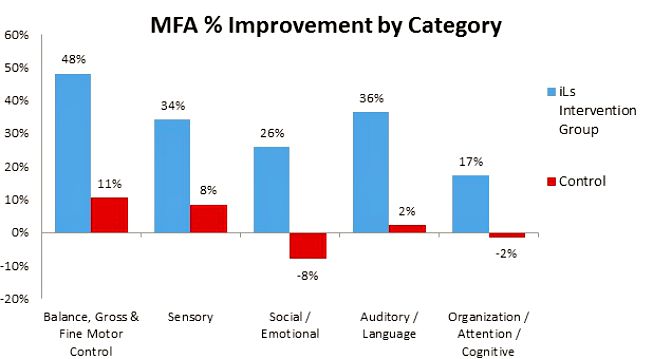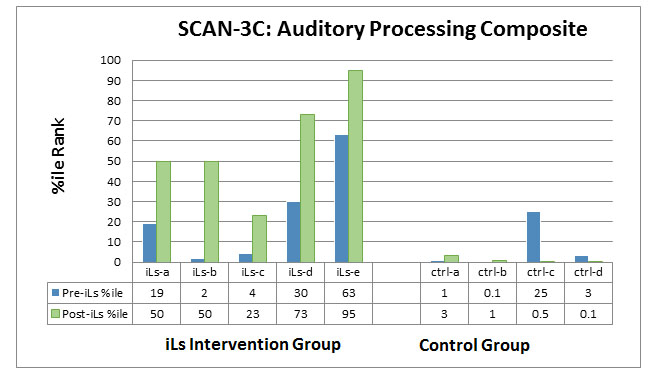AUTHORS: Julaine Tollison, OT, MA and Paul Atherton, PhD
NAME OF ORGANIZATION: Kingsway Elementary School, Port Charlotte, FL
ABSTRACT: This controlled study measures the effect of an iLs school program on ten students diagnosed with ASD. Measures used in the study include the SCAN:3-C, a standardized assessment of auditory processing, and the Measure of Foundational Abilities (MFA), which measures change in five categories: motor, sensory, social/emotional, language and attention/organization. The iLs group received therapy 30 minutes per day, on an average of four days per week while the control group students continued to receive ABA, OT and Speech therapy on their regular weekly schedule. Auditory processing and behavioral changes were significant for the iLs group, with an average gain of 36 in the SCAN:3-C composite percentile rank scores, and a 32% average improvement in the MFA categories. Results for the control group include a change of -6 in the SCAN:3-C composite percentile rank scores and a 2% improvement in the MFA behavioral evaluation.
PROGRAM ADMINISTRATION AND IMPLEMENTATION: iLs was implemented in two groups. Group A received iLs Monday through Friday, first thing in the morning for half-hour sessions. Activities for this group were completed in a separate room to help minimize the distraction of morning announcements and opening routines. Group B followed the same half-hour session schedule 4-5 days per week within the classroom setting. Due to the behavioral complexities of several students in this class, scheduled times of implementation varied depending on the day/class needs. All students were very receptive to participating in iLs. On occasions when sessions were missed, students were asking for the program.
Challenges for implementing within the public school system included: student absences (especially around flu season), Thanksgiving, Christmas and Spring Break (totaling 4 weeks off), and testing schedules (for those students required to participate). Kingsway school administration was very supportive of the iLs therapy throughout the year. Following the first 20 sessions, and after seeing positive results, a paraprofessional was assigned to take over the program’s implementation under the supervision of the Occupational Therapist. This allowed for less interruption to daily sessions due to meetings, absences, teacher/therapist obligations.
PROGRAM RESULTS:
Discussion of Measure of Foundational Abilities (MFA) The data on the graphs below show pre/post results for both groups. All members of the iLs group showed significant improvement in most categories, most notably in the areas of Balance, Gross & Fine Motor Control, Sensory and Auditory/Language. Those in the control group made marginal, if any, improvement across all categories. In general, it is evident that the overall reductions of problems in these key areas were associated with the iLs therapy, especially since both iLs and control students were matched with similar difficulty levels in all areas and comparable Autism Spectrum Rating Scales scores.
SCAN-3: C: The SCAN-3:C is a battery of tests for screening and diagnosing auditory processing difficulties in children. In the auditory figure ground test, examinees hear words or sentences presented in background noise to simulate environments in which listening is difficult, such as listening to conversations at school, restaurants, or at sports events. The stimuli for the filtered words tests are filtered in a way that degrades the signal to simulate real-life conditions such as talking on a cell phone, or listening in class when the teacher is turned towards the chalkboard, away from the class.
Students who received iLs intervention consistently improved in all auditory processing categories. The control group remained at approximately the same levels before and after the 6-month period, during which they received OT, language and/or speech therapy, and ABA, (with a ratio of 3 adults to 12 students).
Conclusion: The data clearly shows significant changes in auditory processing, motor function and behavior for the students receiving iLs. Teachers and parents noted changes in social interactions and emotional regulation which resulted in greater classroom participation and interaction with peers. Stemming behaviors decreased, reciprocity in day-to-day interactions increased.
One child with echolalia was able to initiate relevant conversations with adults and answer “wh” questions by the end of the study. The same student now interacts with the other children during recess and plays on the equipment, neither of which he was able to do prior to the program. Since starting, iLs, there have been no behavioral outbursts or meltdowns at school at all. The iLs group students also saw reductions in or discontinuation of IEPs.
With these overall results and data, we applied for and were awarded a Century Link Technology grant for continued expansion of iLs services and equipment at Kingsway. At Kingsway School, we are excited to be able to expand the iLs program to students in the control group, as well as to others, for the 2015-2016 school year.






 © 2025 Unyte Health US Inc.
© 2025 Unyte Health US Inc.